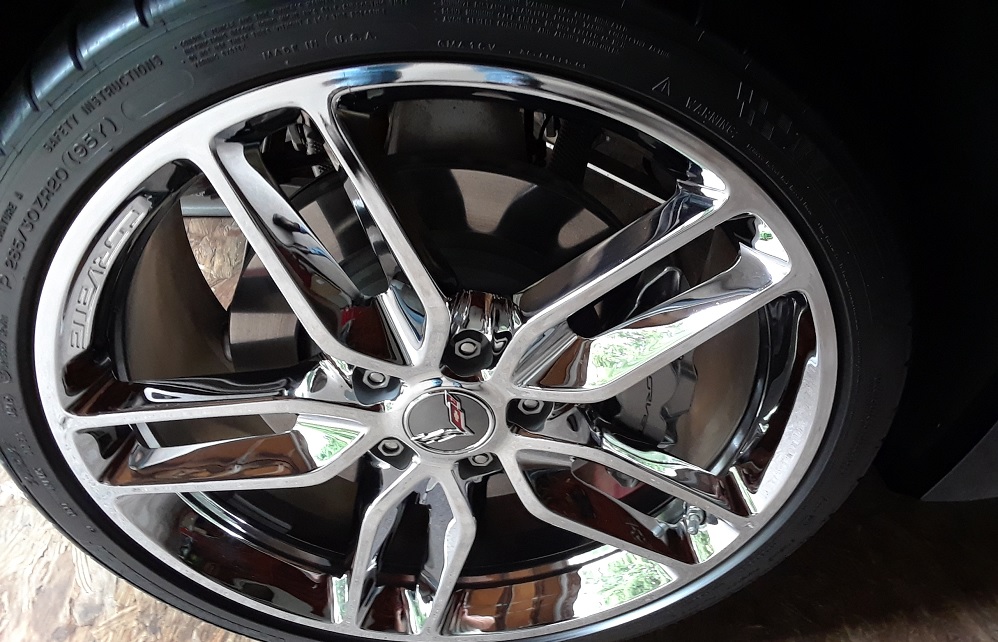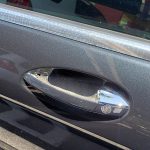Maintaining the pristine shine of chrome surfaces is a pursuit cherished by car enthusiasts, homeowners, and anyone with a penchant for sleek aesthetics. However, the question that often arises is whether brake cleaner, a product known for its potent cleaning abilities, is a safe choice for cleaning chrome. In this detailed exploration, we’ll unravel the complexities surrounding this query, shedding light on the intricacies of cleaning chrome surfaces and providing a comprehensive guide to preserving their brilliance.
Understanding Chrome Surfaces
Before delving into the realm of cleaning agents, it’s crucial to grasp the characteristics of chrome surfaces. Chrome, a metal celebrated for its lustrous finish, is extensively used to coat various items, from automotive parts to household fixtures. Its reflective allure adds a touch of sophistication to our belongings, making proper maintenance essential to sustain its visual appeal.
The Concerns About Brake Cleaner
1. Chemical Reactions:
Chrome, when exposed to certain chemicals, may undergo undesirable reactions leading to discoloration or even structural damage. Brake cleaners, often containing aggressive substances like acetone, raise concerns about the potential harm they may inflict on the delicate chrome layer.
2. Potential Damage:
The abrasive nature of chemicals in brake cleaners can strip the protective layer of chrome, rendering it susceptible to corrosion. The potential for long-term damage makes it imperative to explore alternative cleaning methods.
Safe Cleaning Alternatives
To navigate the delicate task of cleaning chrome without risking damage, consider these alternative methods:
3. Mild Soap and Water:
Commence the cleaning process with a mixture of mild soap and water. Use a soft cloth or sponge to gently cleanse the chrome surface, avoiding abrasive materials that could inadvertently scratch its delicate exterior.
4. Vinegar Solution:
A solution comprising equal parts water and vinegar can be a gentle yet effective option. Applying this mixture with a soft cloth helps eliminate water spots and stains without compromising the integrity of the chrome.
5. Baking Soda Paste:
For stubborn stains, a paste made from baking soda and water can work wonders. Apply the paste, scrub gently, and rinse thoroughly to restore the chrome’s original luster.
Assessing Brake Cleaner Compatibility
6. Check the Ingredients:
Before contemplating the use of brake cleaner on chrome, scrutinize the product’s ingredients. If it contains harsh chemicals like acetone, exercising caution is advisable.
7. Spot Testing:
Mitigate potential risks by performing a small spot test in an inconspicuous area before applying brake cleaner to the entire surface. This preemptive measure allows you to gauge any adverse reactions without compromising the entire chrome finish.
Best Practices for Using Brake Cleaner
Should you opt for brake cleaner as your cleaning agent, adhere to these best practices:
8. Ventilation:
Ensure the space where you’re using brake cleaner is well-ventilated to prevent inhalation of fumes. Additionally, don protective gloves to shield your skin from direct contact with the cleaning solution.
9. Spray Conservatively:
Exercise restraint when applying brake cleaner, ensuring a conservative and targeted application. Oversaturating the chrome surface can lead to unnecessary complications.
10. Immediate Wiping:
Swiftly wipe the treated chrome surface with a clean, dry cloth to eliminate any residue. Prompt action is vital in minimizing the risk of potential damage.
The Nuances of Chrome Care
Beyond the realm of cleaning agents, adopting good practices for overall chrome care is instrumental in preserving its longevity. Here are additional tips: (See Also: Does Armor All Damage Leather? Unveiling the Truth About Leather Care)
11. Regular Polishing:
Incorporate regular polishing into your maintenance routine. Chrome-friendly polishes can add an extra layer of protection and enhance the shine.
12. Avoid Abrasive Tools:
Steer clear of abrasive tools such as steel wool or harsh scouring pads, as they can scratch the chrome surface and compromise its reflective quality.
13. Protect Against Environmental Factors:
Shield chrome surfaces from harsh environmental elements like rain, salt, and pollutants. Regular cleaning can prevent the buildup of corrosive substances.
Expert Tips for Chrome Cleaning and Maintenance
Keeping chrome surfaces in impeccable condition involves a delicate balance of cleaning and maintenance practices. As experts in the field, we’ve curated a set of invaluable tips to elevate your chrome care regimen. Read on for insights that will ensure your chrome continues to shine with enduring brilliance.
1. Gentle Microfiber Cloth Magic:
Opt for microfiber cloths to clean chrome surfaces. Their soft texture minimizes the risk of scratches, providing a gentle yet effective cleaning experience.
2. Mindful Drying Techniques:
After cleaning, use a separate microfiber cloth for drying. Avoid air-drying, as water spots can mar the chrome’s sheen.
3. Chrome-Specific Cleaners:
Invest in cleaners specifically designed for chrome. These products are formulated to clean without causing damage, ensuring a safe and effective chrome care routine.
4. Regular Inspection Rituals:
Periodically inspect your chrome surfaces for any signs of corrosion, discoloration, or damage. Early detection allows for prompt intervention and prevents issues from escalating.
5. Protective Wax Coating:
Apply a high-quality chrome wax or sealant to create a protective barrier. This extra layer shields against environmental factors and prolongs the chrome’s vibrancy.
6. Avoiding Direct Sun Exposure:
Limit prolonged exposure to direct sunlight, as UV rays can accelerate chrome degradation. Parking in shaded areas or using protective covers can mitigate sun-induced damage.
7. Mind the Gaps:
Pay attention to seams and gaps where chrome meets other materials. Dirt and moisture tend to accumulate in these areas, leading to potential corrosion. Regularly clean and dry these spots.
8. Chrome-Plated Wheels:
If dealing with chrome-plated wheels, refrain from using acidic wheel cleaners. Opt for pH-neutral cleaners to preserve both the chrome and any surrounding materials.
9. Moderation in Polishing:
While regular polishing is beneficial, moderation is key. Excessive polishing can lead to product buildup, diminishing the chrome’s reflective quality.
10. Professional Restoration Services:
Consider professional chrome restoration services for heavily tarnished or damaged surfaces. Experts can employ specialized techniques to bring back the chrome’s original luster. (See Also: Will Goo Gone Remove Plasti Dip? A Comprehensive Guide)
11. Mindful Driving Habits:
Be mindful of road conditions and avoid gravel roads whenever possible. Rocks and debris kicked up while driving can cause unsightly dings and scratches on chrome surfaces.
12. Prompt Removal of Bird Droppings:
Bird droppings contain corrosive elements that can damage chrome. Swiftly remove any droppings to prevent long-term harm.
13. Avoiding DIY Chrome Plating:
Refrain from attempting DIY chrome plating. Professional chrome plating services ensure a high-quality finish, whereas DIY methods may result in uneven coatings and potential damage.
14. Chrome Protection Film:
Explore the option of chrome protection films. These transparent films act as a shield, safeguarding against scratches, rock chips, and environmental factors.
15. Knowledgeable Restoration Experts:
If considering chrome restoration, consult with knowledgeable professionals. They can assess the extent of damage and recommend appropriate restoration techniques, ensuring a successful outcome.
Incorporating these expert tips into your chrome care routine will not only enhance the immediate shine but also contribute to the long-term durability of your chrome surfaces. Embrace these practices, and watch as your Chrome continues to be a beacon of brilliance.
Frequently Asked Questions About Cleaning Chrome Surfaces
Navigating the nuances of cleaning and maintaining chrome surfaces can raise various questions. In this FAQ section, we address common queries to provide clarity and guidance on ensuring your chrome retains its dazzling allure.
1. Can I Use Brake Cleaner on Chrome Without Any Risks?
Answer: While brake cleaner can be effective, it comes with risks. The presence of harsh chemicals, such as acetone, may lead to discoloration and damage. It’s advisable to explore alternative cleaning methods to avoid potential harm to your chrome.
2. What Are the Best Alternatives to Brake Cleaner for Chrome Cleaning?
Answer: Opt for mild soap and water, a vinegar solution, or a baking soda paste. These alternatives are gentle yet effective in removing stains and preserving the integrity of your chrome surfaces.
3. How Often Should I Clean My Chrome?
Answer: The frequency of cleaning depends on factors like environmental conditions and usage. As a general guideline, a thorough cleaning every two weeks, along with regular inspections, can help maintain the shine.
4. Is Chrome Wax Necessary, and How Often Should I Apply It?
Answer: Chrome wax creates a protective layer, enhancing longevity. Apply it every three months for optimal results. However, adjust the frequency based on environmental exposure and usage.
5. Can Chrome Surfaces Be Restored if Damaged?
Answer: Yes, professional chrome restoration services can address damage and tarnishing. Consult experts to assess the extent of the damage and determine suitable restoration methods.
6. What Cleaning Tools Are Safe for Chrome Surfaces?
Answer: Use soft microfiber cloths or sponges for cleaning. Avoid abrasive materials like steel wool, as they can scratch the chrome. Additionally, opt for chrome-specific cleaners for safe and effective results. (See Also: How To Fix Dog Scratches On Car Door – Expert Tips for a Flawless Repair)
7. How Do I Protect Chrome-Plated Wheels?
Answer: Use pH-neutral wheel cleaners to protect chrome-plated wheels. Regular cleaning and avoiding harsh chemicals ensure the longevity of both the chrome and surrounding materials.
8. Can I Use Chrome Protection Films for Extra Shielding?
Answer: Yes, transparent chrome protection films act as a shield against scratches, rock chips, and environmental factors. Consider this option for added protection, especially in high-impact areas.
9. What Precautions Should I Take When Using Brake Cleaner?
Answer: Ensure proper ventilation when using brake cleaner to avoid inhaling fumes. Wear protective gloves and spray conservatively. Immediately wipe the treated chrome surface to remove any residue.
10. Are DIY Chrome Plating Methods Recommended?
Answer: DIY chrome plating is not recommended. Professional chrome plating services ensure a high-quality finish, whereas DIY methods may result in uneven coatings and potential damage.
11. How Can I Prevent Water Spots on Chrome?
Answer: Dry chrome surfaces immediately after cleaning to prevent water spots. Using a separate microfiber cloth for drying helps maintain the chrome’s flawless sheen.
12. What’s the Best Way to Remove Stubborn Stains from Chrome?
Answer: For stubborn stains, create a paste using baking soda and water. Gently apply, scrub, and rinse. This method effectively removes stains without compromising the chrome.
13. Is Chrome Care Necessary for Everyday Items at Home?
Answer: Yes, regular chrome care is essential for everyday items at home. Items like faucets, handles, and fixtures benefit from routine cleaning to retain their aesthetic appeal.
14. Can Sunlight Damage Chrome Surfaces?
Answer: Prolonged exposure to direct sunlight can accelerate chrome degradation. Park in shaded areas or use protective covers to mitigate the potential impact of UV rays.
15. What Should I Do if I Notice Signs of Corrosion?
Answer: If you notice signs of corrosion, act promptly. Clean the affected area, apply a chrome-friendly polish, and consider consulting professionals for comprehensive restoration if needed.
Feel free to explore these FAQs to enhance your knowledge and ensure that your chrome surfaces continue to shine with brilliance.
Conclusion
In the pursuit of gleaming chrome, it’s paramount to approach the cleaning process with a blend of enthusiasm and caution. While brake cleaner can be effective, its potential risks necessitate careful consideration. Exploring alternative methods and adopting a holistic approach to chrome care ensures your chrome surfaces continue to dazzle for years to come. So, can you use brake cleaner on chrome? With the right knowledge and practices, the answer leans towards cautious consideration, allowing you to revel in the brilliance of your chrome possessions without compromising their integrity.



